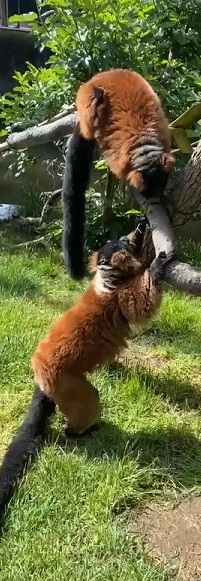Micke Grove Zoo
SJGOV.org - How can we serve you today?
Red Ruffed Lemur
Varecia rubra
- Habitat: Tropical moist lowland forests
- Range: Masaola Peninsula of Madagascar's Northeast coast
- Natural Diet: Fruit, flowers, nectar, leaves, and buds
- Status in the Wild: THREATENED
All about Ring-tailed Lemurs
Lemurs are closely related to other primates such as monkeys and apes and are found in Madagascar. The Ruffed Lemurs (black and white, and red) are similar in size and behavior. Red Ruff Lemurs are medium in size with reddish-brown fur on their backs, arms, and legs. Their underbellies, faces, and tails are black. Like the Black and White Ruffed Lemurs, they sport long bodies and legs with slender snouts. Their tails are usually 2 feet long and are longer than their bodies. Males and females are similar in size (monomorphic) and are around 6 to 8 pounds. Lemurs are arboreal creatures and are active during the day (diurnal) spending most of their time resting in trees. Their body colors help camouflage them hiding them from predators.
Diet/ Habitat/
Range
Red Ruffed Lemurs are endemic to Madagascar and are found in the northeast region which has thick tropical rainforests. These lemurs occupy a smaller distributional range than the Black and White Ruffed Lemurs, and are only found in the Masoala Peninsula area. The Masoala National Park, one of Madagascar’s largest protected parks was notified to conserve Red Ruffed Lemurs.
Both Black and White, and Red Ruffed Lemurs are frugivorous and feed on insects, fruits, flowers, seeds, nectar, and pollen. A considerable proportion of their diet (75% or more) comprises of plant material and fruits. Flower nectar is a very popular seasonal food resource with Red Ruffed Lemurs and they carry the pollen rubbed on their fur from flower to flower. Lemurs are therefore categorized as pollinators.
Behavior
Ruffed Lemurs are highly social animals. In the wild, they live in large family groups of 15 or more lemurs consisting of several males and females. Lemurs are matriarchal and females fill positions of dominance and power in family groups.(matriarchal). , Also, each lemur occupies a position of power in a hierarchical system. These positions are maintained through grooming privileges where subordinate lemurs groom dominant individuals. Dominant lemurs experience several privileges such as primary access to food resources, primary rights to breed, and access to partners.
Lemurs emit several different types of calls for specific purposes. Some of these calls are very loud, especially those made to let neighboring lemur groups know that the territory is occupied. Another vocalization that is most commonly heard is the alarm call emitted to warn members of the group to watch out for predators close by. Lemurs maintain territories to protect their food resources and resting grounds by scent-marking their territorial boundaries with urine.
Reproduction
The breeding season is during the summer months. The males usually initiate the reproductive behavioral sequence by vocalizing with “woos” and scent markings. The gestation period is 3.5 months long at the end of which, two to three young are born.
Lemurs practice biparental care with both males and females taking care of the young. Females build a nest for the infants until they wean. Young lemurs wean at 4 months of age. Since a considerable proportion of behavior in their behavioral repertoire is gained through learning, parents train their young to maintain territories to protect their feeding and resting areas, find food resources, stay alert for predators, and take care of their young.
Conservation/Status
Due to habitat
encroachment and deforestation, Red Ruffed Lemurs are only found in
a narrow stretch of rainforest habitat. Since they are only found in
Madagascar, the International Union for the Conservation of Nature
has categorized them as
CRITICALLY ENDANGERED.
Illegal hunting and trapping that is currently prevalent have also
had a detrimental effect on their numbers in the wild.
These lemurs have a black tail and their bodies are reddish-brown helping them camouflage from predators in their native habitat
When enjoy basking in the sun
.jpg)
Distributional range - they are endemic to Madagascar

They are highly arboreal and spend a considerable proportion of their time in trees

They are highly social and spend time interacting and grooming one another